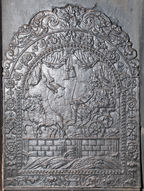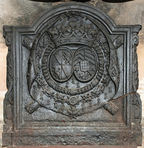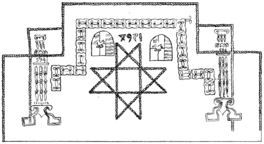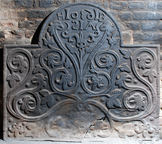-
222
Description: Arched rectangular central panel with ‘nutshell’ edging on a broad fillet; crowned figure, holding a sceptre in his right hand, sitting in a chariot drawn to the left by two horses with ostrich feather head-dresses; the whole upon a causeway with pilasters and masonry, and waves beneath; a heron flying to the left; above, swagged drapery with two tassels hanging from the centre; arched rectangular shaped border with fillet edging, symmetrical, flower bunches, descending from a ribbon loop; monogram centre bottom, between plant tendrils; on top, symmetrical scrolled plant tendrils.
Notes: The design is derived from a personification of Europe, one of a set of playing cards entitled 'Jeu de la Géographie', designed by Stefano della Bella (1677); a similarity with Queen Anne may not be coincidental; the flying heron has been copied from a print by Wenceslaus Hollar c.1658.
Copies of this fireback are known.
Inscription: SHR
- Decoration tags:
- 'Dutch' (shape)
- fillet (edging)
- whole carved pattern
- pictorial
- allegorical
- monogram
- text
- animals
- humans
- objects
Manufactured: in the late-17th to early-18th century in England.
Current location: Canons Ashby House, Canons Ashby, Northamptonshire, England.
Museum number: NT/L/CAN/M/79 (part of the National Trust museum group)
- Attached to series:
- SHR series
- British 'Dutch' style firebacks
-
957
Description: Upon a rectangular base plinth, an arched rectangular, ovolo-moulded panel containing a draped cloth (disclosing on the reverse the arms of Duras) upon which two oval shields are surmounted by a ducal coronet, and encircled by the collars of the Orders of St Michel and Saint-Esprit. Behind the cloth are crossed batons of a Marshal of France; on each side are flattened S-scrolls with tassels.
Notes: In all probability the arms of Jean-Baptiste de Durfort, Duc de Duras (1684-1770), created Marshal of France in 1741.
Arms: Durfort, duc de Duras
- Decoration tags:
- rectangular with round arch (shape)
- ovolo (edging)
- whole carved pattern
- armorial
Manufactured: in the early- to mid-18th century in France.
Current location: Chateau de Duras, Duras, Lot-et-Garonne, France.
- Attached to series:
- Foreign armorial firebacks
-
1015
Description: Rectangular with two-stepped top; twisted rope edging (top and sides); twisted rope extensions enclosing intermediate step with rope continued parallel to sides; central rope octagram with reversed date above between repeated inverted shield shapes off-set (left higher than right); the shield blazon: barry wavy impaling quarterly, overlaid with a small bird stamp and an indistinct ?bird shape in the top left quarter as viewed; within the rope, a roughly parallel arrangement of 23 double-loop-patterned stamps, with the faint impression of an additional stamp in the top right corner of the arrangement; outside the loop stamps and partially overlying the vertical rope extensions, the impressions of two classically designed firedogs with Ionic capitals and fluted pilasters, bearing the date 1594, but with the '1' missing; the fluting on the pilasters has been overlaid by the repeated impression of a turned peg.
Notes: A large and remarkably elaborate fireback: the octagram, a device seen more commonly on French firebacks than on English ones, suggests an apotropaic purpose; the impression of the firedogs was clearly made after the laying of the rope lengths and impressed less deeply as the rope impression has not been obliterated by the firedog on the left side. A fireback with the same loop stamps bears the same date using the same numerals but impressed the correct way round. Currently obscured behind a wood stove.
Inscription: 4951 [5 reversed] / 594 594
- Decoration tags:
- stepped (shape)
- rope (edging)
- simple stamps
- carved stamps
- individual numbers
- apotropaic
- armorial
- text
- objects
Manufactured: in 1594 in the Weald area of England.
Current location: Fyning Manor, Rogate, West Sussex, England.
-
802
Description: Arched rectangular shaped; astragal edging (top and sides); mainly symmetrical vine arrangement, emerging from a vase, some fronds ending in an eagle’s head, other in leaves; at top of arch, initials ‘HB’ split by date (reversed) with an additional ‘I’; below, initials ‘AIS’ (reversed).
Notes: Two planklines; ‘HB’ refers to Henry Bell, who acquired Rake Manor, Witley, in 1592. ‘AIS’ refers to Anthony Smith, his nephew and heir, and his wife, Joan (née Hore); the form of the date is confused by the addition of an ‘I’, and the somewhat clumsy arrangement of the inscription suggests that it was added to the otherwise foliate pattern priot to casting. The letter 'H' seems to belong to a different character set
Copies of this fireback are known.
Inscription: H I0361B / AIS
- Decoration tags:
- rectangular with round arch (shape)
- astragal (edging)
- whole carved pattern
- planklines
- pictorial
- text
- plants
Manufactured: in 1630 possibly at Witley Park Furnace in the Weald area of England.
Current location: Rake Manor, Witley, Surrey, England.
Citation: Giuseppi, M. S., 1903, 'Rake in Witley [etc.]', Surrey Archaeological Collections, 18, pp. 11-60.
- Attached to series:
- Personal firebacks
- Date & initials firebacks



